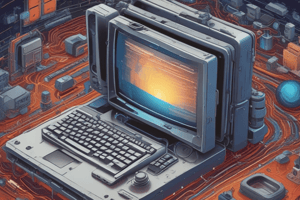Podcast
Questions and Answers
Which category of software helps users increase efficiency and productivity in various tasks?
Which category of software helps users increase efficiency and productivity in various tasks?
- Database management software
- Educational software
- Productivity software (correct)
- Graphics and multimedia software
What type of computer is used by organizations for handling large-scale data processing and transactions?
What type of computer is used by organizations for handling large-scale data processing and transactions?
- Servers
- Mainframes (correct)
- Supercomputers
- Personal computers
What is the purpose of educational software?
What is the purpose of educational software?
- Facilitate learning and educational activities (correct)
- Help users increase efficiency
- Create, edit, and manipulate images
- Provide services or resources over a network
Which type of database management system belongs to the NoSQL category?
Which type of database management system belongs to the NoSQL category?
Which software is used for creating, editing, and manipulating images, videos, and animations?
Which software is used for creating, editing, and manipulating images, videos, and animations?
What is the primary function of system software?
What is the primary function of system software?
What is the purpose of programming software?
What is the purpose of programming software?
Which type of software addresses the needs of organizations and businesses?
Which type of software addresses the needs of organizations and businesses?
What is the primary function of database software?
What is the primary function of database software?
Which type of computer is highly specialized for performing complex calculations and simulations at extremely high speeds?
Which type of computer is highly specialized for performing complex calculations and simulations at extremely high speeds?
Which software is NOT mentioned in the text as an example of productivity software?
Which software is NOT mentioned in the text as an example of productivity software?
In the category of educational software, what are learning management systems (LMS) used for?
In the category of educational software, what are learning management systems (LMS) used for?
Which database management system belongs to the NoSQL category?
Which database management system belongs to the NoSQL category?
Which software is used for 3D modeling and animation?
Which software is used for 3D modeling and animation?
Flashcards are hidden until you start studying
Study Notes
Computer Software
- Computer software is a collection of data or computer instructions that tell the computer how to work.
Types of Computer Software
1. System Software
- Manages computer hardware resources and provides a platform for running application software.
- Examples include operating systems (e.g., Windows, macOS, Linux), device drivers, and utility programs (e.g., antivirus, disk management tools).
2. Application Software
- Designed to perform specific tasks or functions for end-users.
- Examples include word processors (e.g., Microsoft Word, Google Docs), spreadsheets (e.g., Microsoft Excel, Google Sheets), web browsers (e.g., Chrome, Firefox), and media players (e.g., VLC, iTunes).
3. Programming Software
- Provides tools for developers to create, debug, and maintain software applications.
- Includes integrated development environments (IDEs) such as Visual Studio, Eclipse, and Xcode, as well as text editors like Sublime Text and Atom.
4. Enterprise Software
- Addresses the needs of organizations and businesses, often managing large-scale operations.
- Examples include customer relationship management (CRM) software (e.g., Salesforce), enterprise resource planning (ERP) systems (e.g., SAP, Oracle), and business intelligence (BI) tools (e.g., Tableau, Power BI).
5. Database Software
- Manages data storage, retrieval, and manipulation.
- Includes relational database management systems (RDBMS) like MySQL, PostgreSQL, and Oracle Database, as well as NoSQL databases like MongoDB and Cassandra.
6. Graphics and Multimedia Software
- Used for creating, editing, and manipulating images, videos, and animations.
- Examples include Adobe Photoshop (image editing), Adobe Premiere Pro (video editing), Blender (3D modeling and animation), and Audacity (audio editing).
7. Educational Software
- Designed to facilitate learning and educational activities.
- Includes learning management systems (LMS) like Moodle, educational games, simulations, and interactive tutorials.
8. Productivity Software
- Helps users increase efficiency and productivity in various tasks.
- Examples include project management tools (e.g., Asana, Trello), note-taking apps (e.g., Evernote, OneNote), and time management software.
Major Categories of Computers
1. Personal Computers (PCs)
- Include desktops, laptops, and tablets used by individuals for personal or professional tasks.
2. Servers
- Designed to provide services or resources to other computers or users over a network.
3. Mainframes
- Large, powerful computers used by organizations for handling large-scale data processing and transactions.
4. Supercomputers
- Highly specialized computers designed to perform complex calculations and simulations at extremely high speeds, often used in scientific research and engineering.
Studying That Suits You
Use AI to generate personalized quizzes and flashcards to suit your learning preferences.




